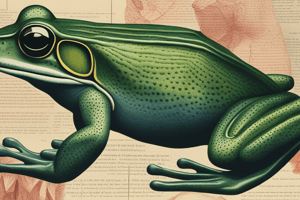Podcast
Questions and Answers
What is the structure that consists of a group of similar cells performing a specific function?
What is the structure that consists of a group of similar cells performing a specific function?
Tissue
Which of the following is considered a cold-blooded animal?
Which of the following is considered a cold-blooded animal?
- Bird
- Fish
- Human
- Frog (correct)
Frogs have a constant body temperature.
Frogs have a constant body temperature.
False (B)
What is the most common species of frog found in India?
What is the most common species of frog found in India?
The protective coloration of frogs to hide from enemies is known as __________.
The protective coloration of frogs to hide from enemies is known as __________.
In which class do frogs belong?
In which class do frogs belong?
What term is used for the study of internal organs in animals?
What term is used for the study of internal organs in animals?
Frogs are capable of living solely in water.
Frogs are capable of living solely in water.
What is the fundamental unit of structure and function in multicellular organisms?
What is the fundamental unit of structure and function in multicellular organisms?
Which of the following is NOT a type of animal tissue?
Which of the following is NOT a type of animal tissue?
What type of epithelial tissue consists of a single layer of cells?
What type of epithelial tissue consists of a single layer of cells?
What are the two types of epithelial tissues?
What are the two types of epithelial tissues?
Where is squamous epithelium typically found?
Where is squamous epithelium typically found?
The __________ epithelium is composed of cube-like cells.
The __________ epithelium is composed of cube-like cells.
What is the main function of columnar epithelium?
What is the main function of columnar epithelium?
Ciliated epithelium helps in moving particles or mucus in a specific direction.
Ciliated epithelium helps in moving particles or mucus in a specific direction.
Flashcards are hidden until you start studying
Study Notes
Organ and Organ System
- Multicellular animals have specialized groups of cells called tissues.
- Tissues work together to form organs.
- Organs work together to form organ systems which perform specific functions.
- The division of labor in organ systems allows for efficient and coordinated activities in the body.
Frogs
- Frogs are amphibians, belonging to the class Amphibia of the phylum Chordata.
- The common Indian frog species is Rana tigrina.
- Frogs are poikilotherms, meaning their body temperature changes with the environment.
- Frogs exhibit camouflage with protective coloration.
- Frogs enter aestivation during summer to escape heat and hibernation during winter to escape cold.
Animal Tissues
- Multicellular organisms have specialized cells that work together to perform specific functions.
- These groups of similar cells with intercellular substances are known as tissues.
- Four basic tissue types are found in complex animals: Epithelial, Connective, Muscular, and Neural.
Epithelial Tissue
- Epithelium is a tissue that covers the surface of the body, body cavities, ducts, and tubes.
- It provides a covering or a lining for different parts of the body and has a free surface.
- Cells are tightly packed with little intercellular matrix.
- Simple epithelium is a single cell layer that functions as a lining for body cavities.
- Compound epithelium is composed of two or more layers and provides protective functions.
- Simple epithelium is further categorized based on cell structure as:
- Squamous epithelium:
- Single layer of flattened cells with irregular boundaries.
- Found in blood vessels and air sacs of lungs.
- Function: diffusion boundary.
- Cuboidal epithelium:
- Single layer of cube-like cells.
- Found in ducts of glands and tubular parts of nephrons in kidneys.
- Function: secretion and absorption.
- Columnar epithelium:
- Single layer of tall and slender cells with nuclei at the base.
- Found in the lining of stomach and intestine.
- Function: secretion and absorption.
- Squamous epithelium:
- Ciliated epithelium:
- Columnar or cuboidal cells with cilia on their free surface.
- Present on the inner surface of hollow organs like bronchioles and fallopian tubes.
- Function: to move particles or mucus in a specific direction.
Studying That Suits You
Use AI to generate personalized quizzes and flashcards to suit your learning preferences.




